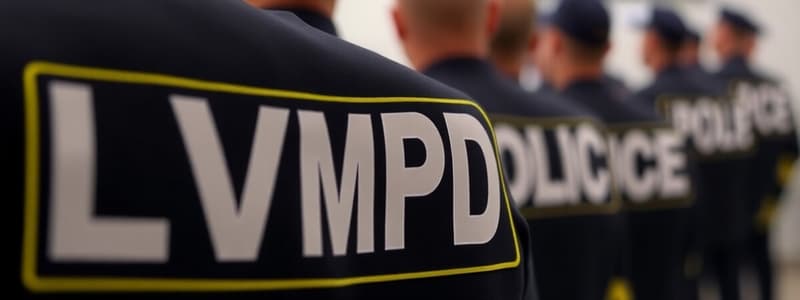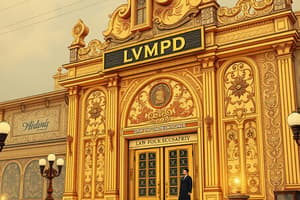Podcast
Questions and Answers
What does the Las Vegas Metropolitan Police Department's 400-code series primarily relate to?
What does the Las Vegas Metropolitan Police Department's 400-code series primarily relate to?
- Robbery and theft incidents (correct)
- Disturbances and fights (correct)
- Vehicle-related incidents (correct)
- Homicide investigations
A '400' code generally indicates what type of incident?
A '400' code generally indicates what type of incident?
- A missing person
- A fire
- A vehicle (correct)
- A traffic stop
What does a '407' code likely refer to in the Las Vegas police 400 codes?
What does a '407' code likely refer to in the Las Vegas police 400 codes?
- Traffic accident with injuries
- Parking violation
- Stolen vehicle (correct)
- Reckless driving
If an officer reports a '417', what is the MOST likely scenario?
If an officer reports a '417', what is the MOST likely scenario?
Which type of incident would be LEAST likely to be classified using a 400-code?
Which type of incident would be LEAST likely to be classified using a 400-code?
What is the primary purpose of using 400-codes in police communication?
What is the primary purpose of using 400-codes in police communication?
Which code might an officer use to report a traffic collision with no injuries?
Which code might an officer use to report a traffic collision with no injuries?
Which of the following situations would MOST likely be reported using a 400-code?
Which of the following situations would MOST likely be reported using a 400-code?
What does the '400' part of the 400-code indicate?
What does the '400' part of the 400-code indicate?
Which incident is LEAST likely to be reported using a 400 series code?
Which incident is LEAST likely to be reported using a 400 series code?
Which of the following explains why police departments use code?
Which of the following explains why police departments use code?
What does the 400 code series focus on in the context of Las Vegas Police?
What does the 400 code series focus on in the context of Las Vegas Police?
Which of the following code is related to stolen vehicles?
Which of the following code is related to stolen vehicles?
If an officer says there's a 417, what are they talking about?
If an officer says there's a 417, what are they talking about?
Which code would LEAST likely be a 400-code by LVPD?
Which code would LEAST likely be a 400-code by LVPD?
What's the major purpose of using the 400 codes?
What's the major purpose of using the 400 codes?
What code refers to a traffic collision with no injuries?
What code refers to a traffic collision with no injuries?
What situation most likely uses the 400 code?
What situation most likely uses the 400 code?
What does '400' mainly tell you?
What does '400' mainly tell you?
Which of the following is LEAST likely to be with a 400 code?
Which of the following is LEAST likely to be with a 400 code?
Flashcards
What are Las Vegas police 400 codes?
What are Las Vegas police 400 codes?
Code used by Las Vegas law enforcement.
Study Notes
- The Las Vegas Metropolitan Police Department (LVMPD) uses 400 codes to communicate efficiently and discreetly over police radios.
- These codes are numerical shortcuts for common situations, requests, and pieces of information.
- Using these codes saves airtime and provides a level of security, as someone not familiar with the codes would not understand the conversation.
- Although specific codes can change or vary slightly, here are some common LVMPD 400 codes:
Common LVMPD 400 Codes
- 400: Used to indicate the acknowledgement of a message; similar to "copy" or "roger".
- 401: Mentions that the dispatcher is busy or occupied and cannot respond immediately.
- 404: Indicates assistance is needed.
- 407: Refers to the arrival at a specific location or scene.
- 408: Signals that an officer is available for assignment.
- 415: Used to report a disturbance.
- 417: Indicates there is a person with a weapon.
- 451: Used to describe animal complaints.
- 452: Indicates traffic hazard
- 457: Used to report drunk drivers.
- 459: Indicates a burglary.
- 460: Signals a robbery.
- 467: Informs that a door or window is found open.
- 486: Used when reporting a suspicious person.
- 487: To report grand theft.
- 488: Signals indecent exposure.
- 496: Used to describe stolen property.
- 497: Vehicle stop.
- 498: Indicates that the unit is at the jail.
- 499: Unit is on the way to the headquarters.
Other Possible Codes
- Though specific codes may be updated, changed, or used differently other codes could include:
- Codes for different types of crimes (assault, fraud, vandalism)
- Codes for traffic-related incidents (accident, reckless driving)
- Codes for medical situations (injury, illness)
- Codes for requests (tow truck, ambulance)
- Codes for describing a person (description, clothing)
- Codes for location information (address, cross streets)
Importance of Context
- It's important to note that the meaning of a 400 code is highly dependent on the context of the communication and the specific policies of the LVMPD.
- These codes create a common language between officers, dispatchers, and other personnel involved in law enforcement activities.
- While 400 codes are designed for efficient communication, clear and concise language is still crucial, especially in critical situations.
- Training is essential for officers to become proficient in using these codes and understanding their meanings.
- 400 codes alone are not sufficient for complete communication, particularly when dealing with complex or unusual situations.
- The use of plain language in combination with 400 codes ensures that messages are easily understood and ambiguities are minimized.
- The specific list of 400 codes and their meanings may not be publicly available to prevent misuse or misunderstanding by the general public.
- LVMPD's communication system is constantly updated to adapt to changing needs and advancements in technology.
- The department regularly reviews and revises its 400 codes to ensure they remain relevant and effective.
- The use of 400 codes is just one aspect of the overall communication strategy employed by the LVMPD.
- Law enforcement agencies often use standardized codes, but there can be local variations.
- Knowledge of these codes is essential for law enforcement professionals in Las Vegas to communicate effectively and efficiently.
- The use of codes helps to quickly relay information during emergencies.
- Proper use of codes can minimize radio traffic and potential misunderstandings.
- The LVMPD communication system includes protocols for handling sensitive information and maintaining confidentiality.
- The system is designed to protect the privacy of individuals involved in law enforcement activities.
- The LVMPD integrates its communication system with other law enforcement agencies to enhance cooperation and coordination.
- The system allows for seamless communication between different jurisdictions during joint operations.
- The LVMPD emphasizes the importance of clear and accurate communication in its training programs.
- Officers are trained to use 400 codes effectively and to avoid ambiguity in their messages.
- The department also provides ongoing training to ensure that officers stay up-to-date on the latest communication protocols.
- This ongoing training helps maintain smooth operations within the department and within the greater Las Vegas area.
Studying That Suits You
Use AI to generate personalized quizzes and flashcards to suit your learning preferences.


